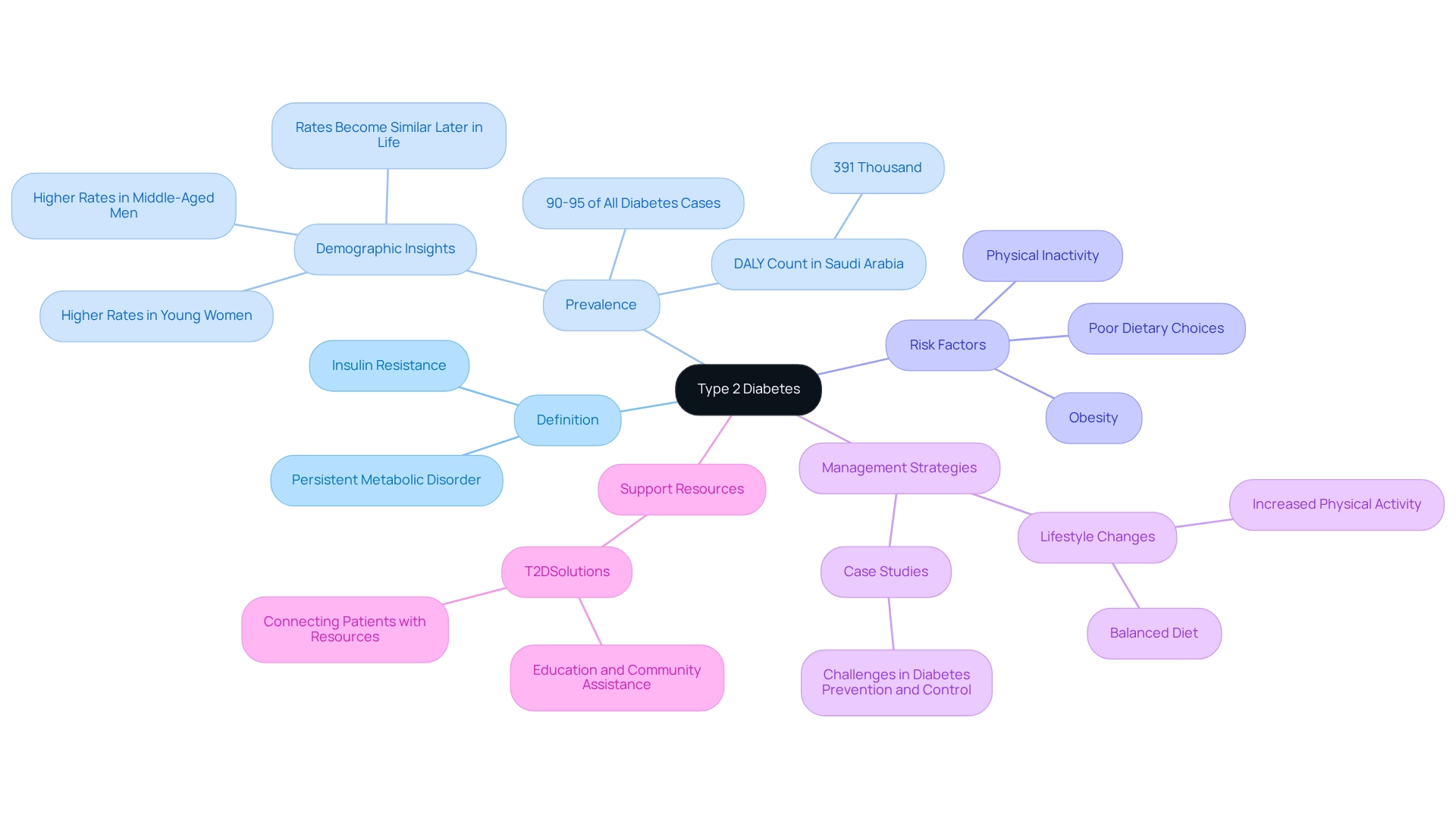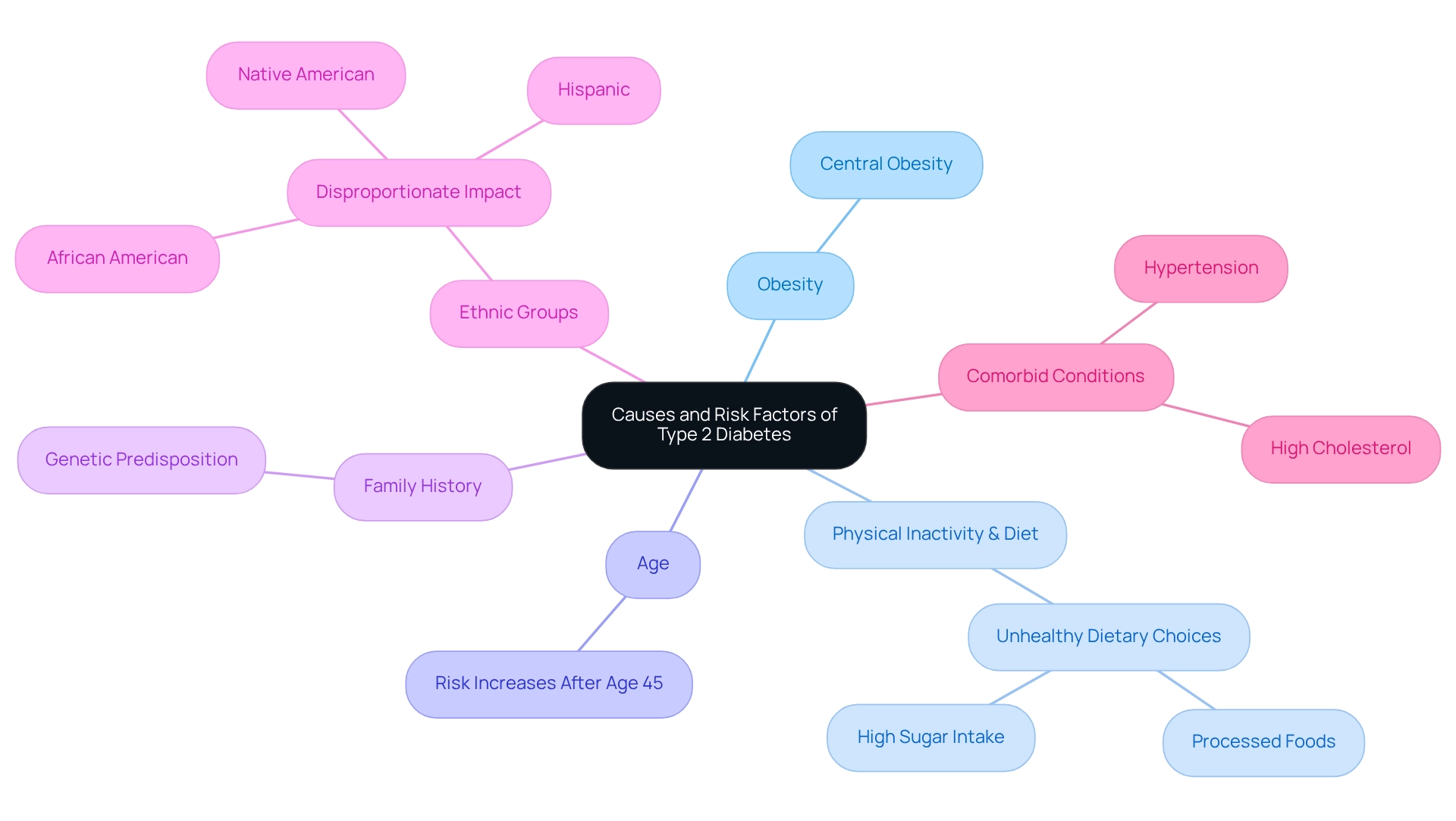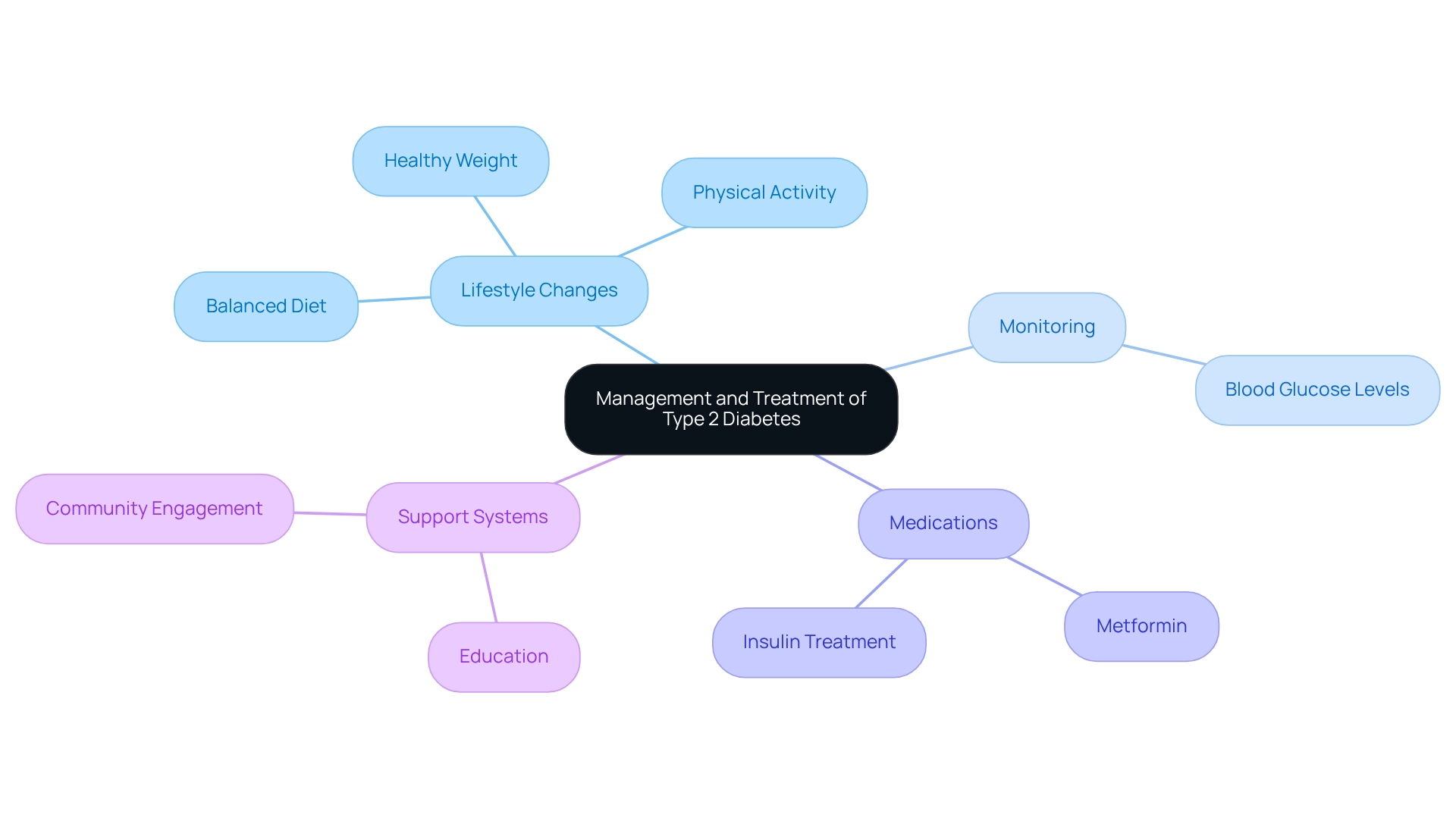Overview
This article offers a comprehensive understanding of type 2 diabetes, a metabolic disorder that can feel overwhelming. It's characterized by insulin resistance, often influenced by lifestyle factors like obesity and physical inactivity. You're not alone in facing this condition; many are experiencing similar challenges.
Data shows that the prevalence of type 2 diabetes is rising globally, particularly among specific demographics. This highlights the importance of effective management strategies and lifestyle changes. It's understandable to feel concerned, but there are steps you can take to prevent and control this condition.
By embracing healthier habits and seeking support, you can make a significant difference in your journey. Remember, we are here to support you every step of the way.
Introduction
In a world where lifestyle choices increasingly shape our health, Type 2 Diabetes stands as a significant challenge, impacting millions around the globe. This chronic metabolic disorder, marked by insulin resistance, often develops quietly, leaving individuals unaware of its presence until serious complications emerge. It's alarming to see the rising statistics, especially among certain demographics, making it crucial to understand the complexities of Type 2 Diabetes—from its causes and risk factors to its symptoms and management strategies.
You're not alone in this journey. As healthcare professionals and resources like T2DSolutions strive to empower you with knowledge and support, the path toward effective management and prevention becomes a shared responsibility. Together, we can emphasize the importance of proactive health measures in combating this pervasive condition. Remember, we are here to support you every step of the way.
Define Type 2 Diabetes: Understanding Its Core Meaning
The condition described here is commonly understood as type 2 diabetes meaning, a persistent metabolic disorder characterized by insulin resistance, where the body does not use insulin efficiently, leading to increased blood glucose levels. The type 2 diabetes meaning typically refers to a condition that develops gradually and is closely linked to lifestyle factors such as obesity, physical inactivity, and poor dietary choices. This condition, which aligns with type 2 diabetes meaning, represents the most prevalent form of diabetes, accounting for approximately 90-95% of all diabetes cases worldwide.
Recent worldwide data show a troubling increase in the prevalence of the second category of diabetes, impacting millions across various demographics. Notably, young women exhibit higher rates of type 2 diabetes meaning, while men show increased rates during middle age, with these trends becoming more similar later in life. In Saudi Arabia, the burden of this condition is significant, with a Disability-Adjusted Life Years (DALY) count of 391 thousand, underscoring the critical need for effective management and prevention strategies.
It's understandable to feel overwhelmed by the persistent difficulties in preventing and managing this condition. This emphasizes the essential requirement for a deeper understanding of contributing elements, especially obesity, which has a considerable influence on the development of the illness. A study titled "Challenges in Diabetes Prevention and Control" highlights that, despite being largely preventable and potentially reversible, the prevalence of this health issue continues to rise globally. This necessitates a better understanding of risk factors and disparities across populations.
Recent studies highlight the significance of addressing insulin resistance as a crucial element of managing glucose intolerance. Effective lifestyle changes, such as adopting a balanced diet and increasing physical activity, have proven beneficial in managing the condition. For instance, case studies illustrate how individuals have successfully reversed insulin resistance through targeted interventions, showcasing the potential for improved health outcomes. Real-world examples include incorporating more whole foods into meals, engaging in regular physical activity like walking or cycling, and utilizing community resources for support.
Defining type 2 diabetes meaning is essential for effective management and prevention. Healthcare professionals describe the type 2 diabetes meaning as a condition that not only affects blood sugar levels but also has far-reaching implications for overall health. Sir Zumla, a UK-NIHR Senior Investigator, notes that with appropriate measures and lifestyle modifications, diabetes prevention is achievable. This understanding enables individuals to take proactive measures in their health journey, reinforcing the idea that the condition, while serious, can be managed effectively with the right knowledge and support.
At T2DSolutions, we strive to offer extensive resources, education, and community assistance for individuals handling the second type of diabetes. By connecting patients with valuable information and support networks, T2DSolutions seeks to empower individuals to take control of their health and navigate their diabetes journey with confidence. Remember, you're not alone in this journey; we urge you to connect with T2DSolutions for additional information and assistance in managing second type of blood sugar issues.

Identify Causes and Risk Factors of Type 2 Diabetes
At T2DSolutions, we genuinely care about offering extensive education and support for individuals managing their second form of diabetes. It's important to understand the type 2 diabetes meaning, as its onset is influenced by a complex interplay of genetic and environmental factors. Among the main contributors:
- Obesity—especially central obesity—stands out as a significant factor, as it worsens insulin resistance.
- Physical inactivity and unhealthy dietary choices, particularly those rich in processed foods and sugars, further increase the risk.
- Age plays a crucial role; the likelihood of developing diabetes rises significantly after the age of 45.
- Family history is also essential, with individuals having a parent or sibling with the condition facing a heightened risk.
- Specific ethnic groups, such as African American, Hispanic, and Native American populations, are disproportionately affected, underscoring the importance of demographic factors in assessing risk for this condition.
- Comorbid issues like hypertension and high cholesterol can elevate the chances of developing this type 2 diabetes meaning, presenting a complex health challenge.
Recent studies have highlighted the concerning link between rising obesity rates and the prevalence of type 2 diabetes. According to the International Diabetes Federation (IDF), the number of adults diagnosed with the condition increased from 415 million in 2015 to around 573 million in 2021, with projections suggesting that this number could rise by another 200 million by 2040. This trend emphasizes the urgent need for effective management strategies.
Experts support these findings, with endocrinologists noting that lifestyle changes, such as weight management and increased physical activity, are vital in reducing risk factors. Current clinical studies are exploring innovative methods to prevent obesity and related conditions, aiming to provide new insights into effective management.
At T2DSolutions, we invite newly diagnosed patients to explore our resources and support systems designed to help you manage these challenges effectively. Case studies, including those advocating bariatric surgery for individuals with obesity-related comorbidities, highlight the critical role of surgical interventions in managing blood sugar levels when conventional methods fall short. These insights stress the importance of a comprehensive approach to managing blood sugar issues, especially for individuals with a body mass index (BMI) exceeding 35, as obesity significantly increases the likelihood of developing type 2 diabetes meaning.
In conclusion, understanding the multifaceted aspects of type 2 diabetes meaning is essential for those recently diagnosed. By recognizing the key risk factors and the relationship between genetics and lifestyle, you can take proactive steps toward effective management and improved health outcomes. Remember, you're not alone in this journey. We invite you to subscribe to T2DSolutions for ongoing support and updates on management strategies for blood sugar regulation.

Recognize Symptoms and Complications of Type 2 Diabetes
As T2DSolutions launches as a new resource hub for glucose regulation education and management, it’s essential for newly diagnosed patients to understand the type 2 diabetes meaning and identify the signs, which often develop gradually and can be easy to overlook. Common indicators include:
- Increased thirst
- Frequent urination
- Extreme hunger
- Fatigue
- Blurred vision
- Slow-healing sores
Many individuals may remain unaware of these symptoms until they lead to more serious complications.
The possible complications of uncontrolled Type 2 Diabetes can be serious, including:
- Cardiovascular disease
- Nerve damage (neuropathy)
- Kidney impairment
- Eye issues (retinopathy)
- Foot problems that may lead to infections or amputations
It’s understandable to feel overwhelmed by this information, but recognizing these signs early can make a significant difference in your health journey.
Statistics show that the occurrence of this metabolic disorder is substantial, impacting roughly 7.4% of non-Hispanic whites and 15.1% of American Indians. This underscores the significance of awareness and early detection. Furthermore, excess medical expenses related to this condition have risen from $10,179 to $12,022 between 2012 and 2022, highlighting the financial consequences of unmanaged Type 2 Diabetes. Understanding these symptoms and their associated risks is crucial for individuals at risk, as early intervention can significantly improve management and reduce the likelihood of severe health issues related to type 2 diabetes meaning. Healthcare professionals emphasize that meeting with a diabetes educator can provide valuable support and guidance, helping patients navigate their condition effectively. You're not alone in this journey; support is available. As T2DSolutions continues to develop, it will offer resources and support for recognizing these symptoms and managing diabetes effectively.
Recent research underscores the importance of recognizing early symptoms to prevent complications. For example, a case study on the reasons for insulin-dependent diabetes mellitus illustrates how insulin resistance results in elevated blood sugar levels, emphasizing the necessity for proactive management. Furthermore, the CDC observes that Type 2 Diabetes is rising among all ethnicities around puberty, which is significant for newly diagnosed individuals. By being vigilant about symptoms and seeking timely medical advice, individuals can take significant steps toward better health outcomes.
To stay updated on the latest resources and support available through T2DSolutions, consider subscribing for email updates. We are here to support you every step of the way.
![]()
Explore Management and Treatment Options for Type 2 Diabetes
Effectively managing this condition requires a multifaceted approach that combines lifestyle changes, regular monitoring, and suitable medication. Key lifestyle modifications include:
- Adopting a balanced diet rich in whole foods
- Engaging in consistent physical activity
- Achieving a healthy weight
These changes not only help regulate blood sugar levels but also contribute to overall well-being. It's important to note that studies indicate lifestyle interventions can significantly reduce the risk of developing diabetes. For instance, data from the National DPP lifestyle change program shows that 6.9 individuals must participate in a three-year intervention to prevent one case of diabetes.
Monitoring blood glucose levels is essential for understanding how dietary choices, physical activity, and medications impact blood sugar. Medications commonly prescribed include metformin, which enhances insulin sensitivity, along with other agents that aid in lowering blood sugar levels. In specific scenarios, insulin treatment may be necessary to attain optimal control, and experts emphasize the essential role of lifestyle modifications in understanding type 2 diabetes meaning. Certified Diabetes Educators highlight that ongoing education and support are vital for enhancing self-management skills. This support can lead to improved medication adherence rates, which are crucial for effective management of the condition. Seyedeh Mahdieh Namayandeh observes that although lifestyle modification strategies demonstrate a decrease in the risk of the condition, they appear especially effective in preventing it over an extended period. Real-world examples show that individuals who implement lifestyle modifications, such as increased physical activity and dietary adjustments, often experience significant improvements in their health outcomes.
Furthermore, case studies reveal the broader health benefits of lifestyle change programs, such as the National DPP. These programs not only focus on preventing diabetes-related issues but also lead to reductions in conditions like sleep apnea and enhancements in mental health. The cumulative enrollment in the National DPP highlights the need for innovative outreach strategies to engage more participants. These findings underscore the importance of a holistic approach to diabetes management, where lifestyle changes, mental health support, and community engagement play pivotal roles in achieving long-term health benefits. Remember, you're not alone in this journey; we are here to support you every step of the way.

Conclusion
Understanding Type 2 Diabetes is crucial in navigating its complexities and managing its impact on health. This chronic metabolic disorder, characterized by insulin resistance, is influenced by various risk factors, including obesity, physical inactivity, and dietary choices. The rising prevalence, particularly among certain demographics, underscores the urgency for awareness and proactive management strategies. Recognizing the symptoms and potential complications associated with Type 2 Diabetes is vital for early intervention, which can significantly improve health outcomes and reduce the risk of severe complications like cardiovascular disease and neuropathy.
Effective management of Type 2 Diabetes requires a multifaceted approach that blends lifestyle modifications, regular monitoring, and appropriate medical interventions. Adopting a balanced diet, engaging in regular physical activity, and maintaining a healthy weight are foundational steps. Moreover, the role of healthcare professionals and support networks cannot be overstated, as they provide essential guidance and resources for individuals on their diabetes journey.
Empowerment through education and community support is key. Initiatives like T2DSolutions are committed to equipping individuals with the knowledge and resources necessary to take control of their health. By fostering a collaborative approach to diabetes management, the goal is to not only mitigate the effects of this condition but also to inspire a proactive stance toward health and well-being. Remember, while Type 2 Diabetes presents challenges, with the right tools and support, effective management and prevention are attainable. You're not alone in this journey; we are here to support you every step of the way.
Frequently Asked Questions
What is type 2 diabetes?
Type 2 diabetes is a persistent metabolic disorder characterized by insulin resistance, where the body does not use insulin efficiently, leading to increased blood glucose levels.
What are the main lifestyle factors linked to type 2 diabetes?
The development of type 2 diabetes is closely linked to lifestyle factors such as obesity, physical inactivity, and poor dietary choices.
How prevalent is type 2 diabetes worldwide?
Type 2 diabetes is the most prevalent form of diabetes, accounting for approximately 90-95% of all diabetes cases worldwide.
Which demographics are most affected by type 2 diabetes?
Recent data indicate that young women exhibit higher rates of type 2 diabetes, while men show increased rates during middle age, with trends becoming more similar later in life.
What is the situation of type 2 diabetes in Saudi Arabia?
In Saudi Arabia, the burden of type 2 diabetes is significant, with a Disability-Adjusted Life Years (DALY) count of 391 thousand, highlighting the need for effective management and prevention strategies.
Why is understanding obesity important in relation to type 2 diabetes?
Obesity has a considerable influence on the development of type 2 diabetes, making it essential to understand its role in prevention and management of the condition.
What lifestyle changes can help manage type 2 diabetes?
Effective lifestyle changes include adopting a balanced diet, increasing physical activity, and incorporating more whole foods into meals.
Can type 2 diabetes be reversed?
Yes, case studies have shown that individuals can successfully reverse insulin resistance through targeted interventions, leading to improved health outcomes.
What role do healthcare professionals play in managing type 2 diabetes?
Healthcare professionals describe type 2 diabetes as a condition that affects blood sugar levels and has far-reaching implications for overall health, emphasizing that prevention is achievable with appropriate measures and lifestyle modifications.
How can T2DSolutions assist individuals with type 2 diabetes?
T2DSolutions offers extensive resources, education, and community assistance to empower individuals in managing their diabetes and navigating their health journey confidently.



